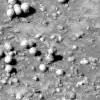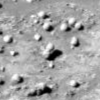Dimpled spherule, in situ
Shortly after landing in Eagle Crater in Meridiani Planum, Opportunity soon made an amazing discovery. Meridiani Planum was covered in curious little spherules. These spherules appeared to be embedded in the sedimentary bedrock beneath the plains as well as scattered across the surface. Composed mostly of Hematite, the spherules were and continue to be a great mystery. Where did they come from? How did they form?
The only reasonable answer to these questions was that the spherules were some kind of hematite concretion, formed in the sedimentary bedrock some time after it was deposited. In fact, there are sandstone formations in Utah in which we find very similar hematite concretions. However, the Martian spherules exhibit bizarre features which can not easily be explained if they are concretions. For example, some spherules can be seen eroding from the bedrock attached to slender, delicate looking stems or stalks. Some spherules have a single regularly shaped dimple or hole. Other spherules may exhibit one or more seams, running approximately half way around the spherule, like the seam of a peach. How can these features be explained if the spherules are concretions? Nature is full of beautiful surprises, and minerals and mineral concretions can create structures of amazing complexity, but what process can account for ALL of the amazing features we see on the Martian spherules?
Here are some specific examples of the amazing features of the spherules.
Dimpled spherules, smaller spherule with "hole" near left edge (see full image)
Spherule with "hole" in situ (see full image, spherule is in shadow in upper part of image)
Many spherules show a single, pronounced dimple. The dimples could be marks left where a stalk had been attached. Again, this is highly suggestive of a biological origin. The dimples together with the seams can form a structure similar to a peach or other fruiting body. I am not sugesting that they are fruiting bodies, simply that the seams, dimples, and surface texture together are all biomarkers. They indicate these things may have been living, growing organisms.
Outcrop covered with spherules, many on stalks, Sol 85
Outcrop with spherules on very long stalks, Sol 164
Some images show spherules with long delicate looking stalks with clear shadows. How could such a feature form as part of a concretion or some other mineral process? Some concretions can form with spikes, as shown below in the disussion of the Mount Signal sand spikes, but the stalks seen in these images are quite different.
Spherules with seams, on surface
Spherule, in situ, with seam not following bedding plane
The presence of seams is significant. In fact, the spherule with a seam, in situ, shown in this picture above was used as evidence that the stratigraphy seen in the outcrop was preserved in the spherules, and therefore the spherules must be concretions, since they obviously formed AFTER the outcrop sediments were deposited. However, the seam on that spherule is a common feature seen on many spherules. In fact, in the other spherule shown above, the seam is pointing down, not in the direction of the bedding plane. Note that for some reason the NASA image is presented upside down, you can see the image is illuminated from "below", which shows that it is upside down. In any case, the seams do not always follow the geometry of the beds in the outcrop. As stated above, the beds clearly deform around the spherules. In some of these images, the seams suggest bilateral symetry, like the seam of a peach. This is another strong indicator that the spherules were formed through a biological process.

Microscopic panorama from "The Dells" Sol 41
[
Larger image
]
Spherule in situ, deformed bed
Another spherule in situ, deformed bed
Although NASA has stated that beds do not deform around the spherules, this large microscopic panorama clearly shows that the beds DO deform around the spherules. This shows that the spherules were deposited in the outcrop as it the beds were still forming. You can see the beds deform both above and below several spherules in this image. Note the spherule nearest the center of the image, and the spherule to the left and slightly below that one. If the spherules formed long after the beds were deposited, the beds would not deform around them.
Although interesting, double or triple spherules are relatively easy to explain mineralogically. Concretions which nucleate close together will naturally merge as they grow. However, local conditions will affect how often concretions nucleate. If nucleations occur close together, in some places we would expect to see large numbers of spherules clumped together. It is perhaps more significant that we do not see large irregular conglomerations of spherules. This is what we might expect to see if they were concretions. In fact, moqui marble hematite concretions occur in a large range of shapes an sizes, and where conditions are right they merge into a large, irregularly shaped mass of hematite. He have not seen the spherules occuring in this manner.



Vertical stacks of spherules, Sol 162,
animations copied from http://home.comcast.net/~charlie6space/Mars
In addition to double and triple spherules lying flat on the surface, stacked spehrules appear to be 2 or more spherules which are cemented together and aligned vertically. This is a very peculiar arrangement.
This fine surface texture is not reproduced in any terrestrial concretions that I know of. Here some spherules where excavated in a trench, but the same texture can be seen on spherules still in situ in the outcrop. The shiny texture could easily be produced by some kind of salty encrustation, but the dimply appearance is suggestive of a biological origin.
The closest analogy on earth are moqui marbles, aka utah berries, which are hematite nodules which form in sandstone formations in Utah and other parts of the western United States. However, moqui marbles do no exhibit stalks, seems, and dimples like we see in the spherules. Also, the matrix whihc they form in is significantly different in physical structure and chemistry from the sulfate matrix where the martian spherules are found. The moqui marbles form in clastic sand stone, by depositing hematite in the open spaces between sand particles in the sand stone. It is the clastic nature of the sandstone which both allows the mineralized water to permeate the rock and provides spaces to incorporate the hematite as the concretions grow. Furthermore, moqui marbles do no deform bedding plains in the sand stone. The sulfate matrix in which the martian spherules are found appears to be evaporitic, not clastic, so the physical and cehmical processes which control concretion gorwth would be very different. This is not to say that this precludes the possibility that the spherules are concretions, just that if they are concretions the moqui marbles are not an analogy for the mechanism by which they formed. They are similar to the moqui marbles in that they are both spherical and both contain hematite, it does not follow that they formed by the same process because the matrix is evaporitic sulfates, not porous clastic sandstone. If, however, there is a process which can form moqui marbles on earth, it is not unreasonable that there is some process which might produce similar structures on mars, including seems, dimples, and stalks, although I do not know what such a process would be. The process which creates the moqui marbles themselves has not been studied extensively and so itslef is only vaguely understood. The moqui marbles on earth are a mineralogical curiousity and no more, a testament to the strange and bizzare of the mineral world.
These concretions form with odd spikes, but do not show the other features of the martian spherules. Futhermore, they are themselves unexplained, and damp and extremely delicate when first excavated. They also form almost uniformly with the spike facing west, which has also never been explained. They were found in sandy deposits in Imperial Valley, and were made of the same sandy material in which they were found, cemented by common calcite. Although odd, the correlation with the martian spherules is anecdotal at best. And, again, the matrix for the sand spikes is obviously SAND, not even sandstone. It is clastic in nature, nothing like the evaporitic sulfates where the martian spherules are found. The physical and chemical differences in the matrix would have significant impact on mineralization. Mineralized water can easily permeate the clastic material, it mechanically flows throught eh spaces between the particles. This can not happen in an evaporite, for one thing there are no spaces for water to flow through, and for another thing the evaporite itself would dislove in the water, chemically altering the water. Water could permeate an evaporite, but this would occur through chemical solvent action, not mechanical flow.
While it is quite a stretch to propose a biological analogy for the spherules, they do show striking similarity to a primitive terrestrial plant known as pachytheca. Pachytheca are tiny primitive plants from the upper silurian and the lower devonian periods of earth's history.
Although it is highly improbable that the spherules are directly related to pachytheca, they could be a similar type of organism. Pachytheca are very primitive organisms. Similar organisms may have evolved millions of years ago on mars, before the climate became dry and cold as it is today.So, both of the closest physical analogies on earth are in clastic materials, not evaporites, and the differences in the action of water on these two substrates are significant. There is no analogy I know of, on earth, involving similar formations in a sulfate evaporite, or in any kind of evaporite. In fact, I do not know of any case where hematite specifically is found associated with an evaporitic sulfate matrix.
On the other hand, many of the features seen in the spherules do have obvious analogies in biology. The textures, bilateral symmetry, stalks, and seems make them look in different ways like many terrestrial organisms. The only question is which explanation is correct, mineralogy or biology?
The only thing that is clear about the spherules is that they are not easily explained. They exhibit features which defy any simple explanation or terrestrial analogy. The most bizzare features are probably the stalks/stems and the fact that they stack on top of eachother, both of which seem to defy the laws of physics. They are an enigma. However, a great mystery like the spherules begs to be solved, and to be sure one day it will be solved. The answer to this puzzle may be more fascintating than the puzzle itself, only time may tell.
I am trying to compile a Spherule Database with some measurements, data, and locations of ever spherule imaged with the MI camera.
If you wish to post a comment, just send me an email at
